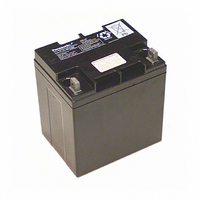LC-X1228P Panasonic - BSG, LC-X1228P Datasheet - Page 22

LC-X1228P
Manufacturer Part Number
LC-X1228P
Description
BATT SEALED LEAD ACID 12V 28AH
Manufacturer
Panasonic - BSG
Series
LCr
Datasheet
1.LC-X1228AP.pdf
(67 pages)
Specifications of LC-X1228P
Voltage - Rated
12V
Capacity
28Ah
Size / Dimension
6.47" L x 4.92" W x 6.89" H (165mm x 125mm x 175mm)
Termination Style
Nut/Bolt, M5
Rechargeability
Yes
Weight
25 lbs (11.3kg)
For Use With
BVW122250003N - BATTERY CHG UNIV 12VDC @ 2.25A271-2390 - BATTERY CHG UNIV 12VDC @ 2.25A271-2386 - BATTERY CHG UNIV 12VDC @ 1.2A271-2385 - BATTERY CHG UNIV 12VDC @ 600MA271-2382 - BATTERY CHG UNIV 12VDC @ 500MA271-2381 - BATTERY CHG UNIV 12VDC @ 500MA271-2380 - BATTERY CHG 120VAC 12VDC @ 500MA271-2378 - BATTERY CHG 120VAC 12VDC @ 300MAPATC-08 - BATT CHARGER 12V 1.5A X 2 UNITPATC-03 - BATTERY CHARGER 12 VOLT 1.5 AMP
Lead Free Status / RoHS Status
Contains lead / RoHS compliant by exemption
Other names
LC-X1228
LC-XB1228
LC-XB1228P
LCX1228P
P049
LC-XB1228
LC-XB1228P
LCX1228P
P049
(2) Stand-by/Back-up use
The application load is supplied with power from AC
sources in normal state. Stand-by/back-up use is to
maintain the battery system at all times so that it can
supply power to the load in case the AC input is
disrupted (such as a power failure). There are two
methods of charging for this use.
(a) Two-step constant voltage charge control
Charging characteristics of the two-step constant
voltage control charger
Block diagram of the two-step constant voltage
control charger
CHARGING METHODS - CONTINUED
method
Two-step constant voltage charge control method
uses two constant-voltage devices. At the initial
stage, the battery is charged by the first constant-
voltage device SW(1) of high setup voltage (set-up
for cycle charge voltage). When the charge
current, the value of which is detected by the
current-detection circuit, has reduced to the preset
value, the device is switched over to the second
SW(2) of low set-up voltage (setup for trickle
charge voltage). This method has the advantage
that the battery in trickle use can be charged in a
comparatively short time for the next discharge.
AC
input
Charge current
Voltage
switch
SW(1)
Charging time
Voltage
switch
SW(2)
Current
detection
circuit
Battery voltage
SCR
VRLA BATTERIES PAGE 21
Battery
(b) Compensating charge (Trickle charge)
Trickle charge system model
Precautions on charging (Trickle charge)
1. As the battery continues to be charged over a long
2. As charge characteristics of the battery are
In this charge system, the battery is disconnected
from the load and kept charged with a small
current only for compensating self discharge while
AC power is alive. In case of power failure, the
battery is automatically connected to the load and
battery power is supplied. This system is applied
mainly as a spare power source for emergency
equipment. In this use, if rapid recovery of the
battery after discharge is required, it is necessary
to consider the recovery charge with a
comparatively large current followed by trickle
charge, or alternative measures. (See two-step
constant voltage charge control method)
While the type and capacity of the battery is
determined by the back-up time and the load
(current consumption) during power failure, some
reserve power should be taken into account
considering such factors as ambient temperature,
capability of the charger and depth of discharge.
period, a small difference in charging voltage may
result in a significant difference in the battery life.
Therefore, charge voltage should be controlled
within a narrow range and with little variation for a
long period.
dependent on temperature, compensation for
temperature variation is required when the battery
is used over a broad temperature range, and the
system should be designed so that the battery and
the charger are kept at the same temperature.
AC
Rectifier
Battery
AUGUST 2003
Load
Power
detection
relay






















